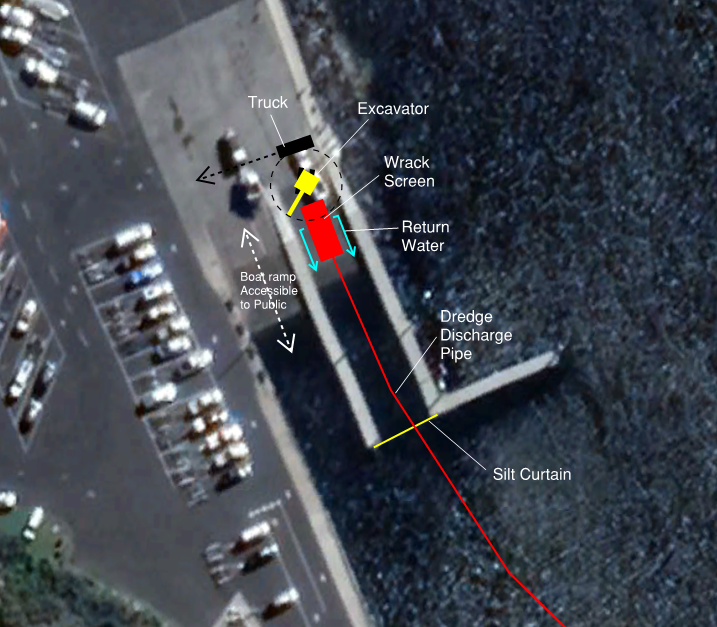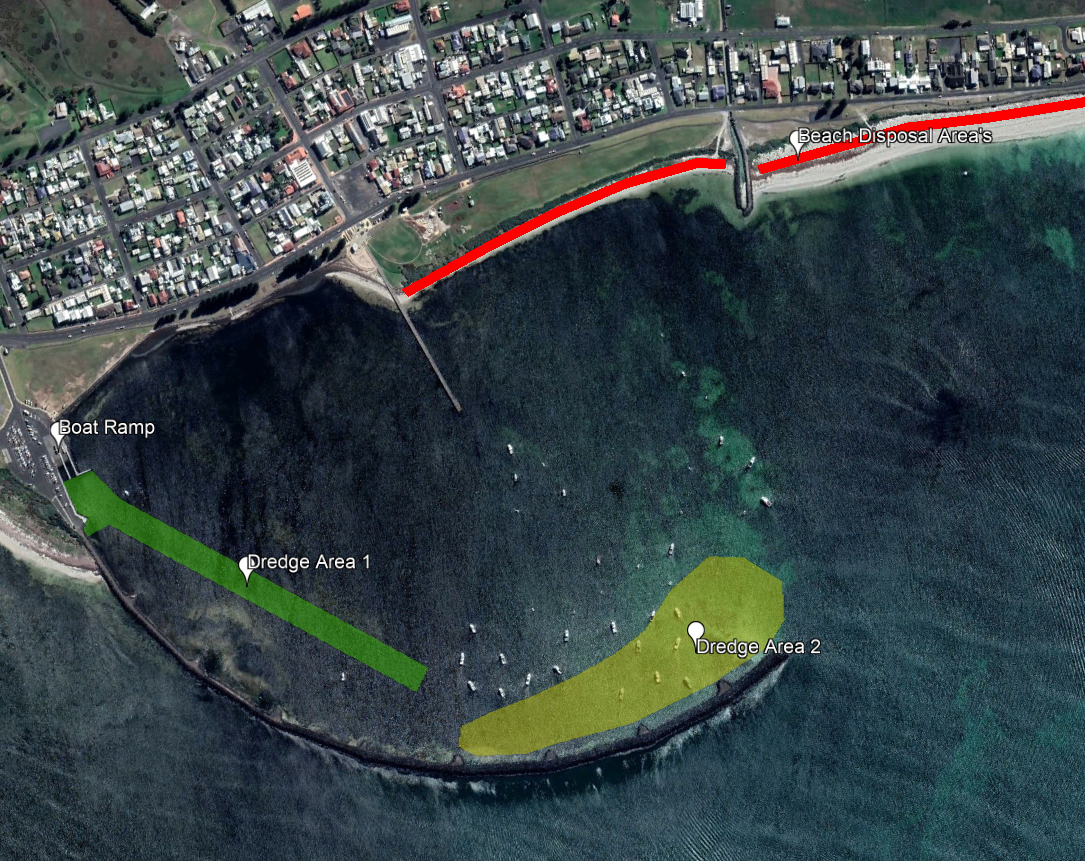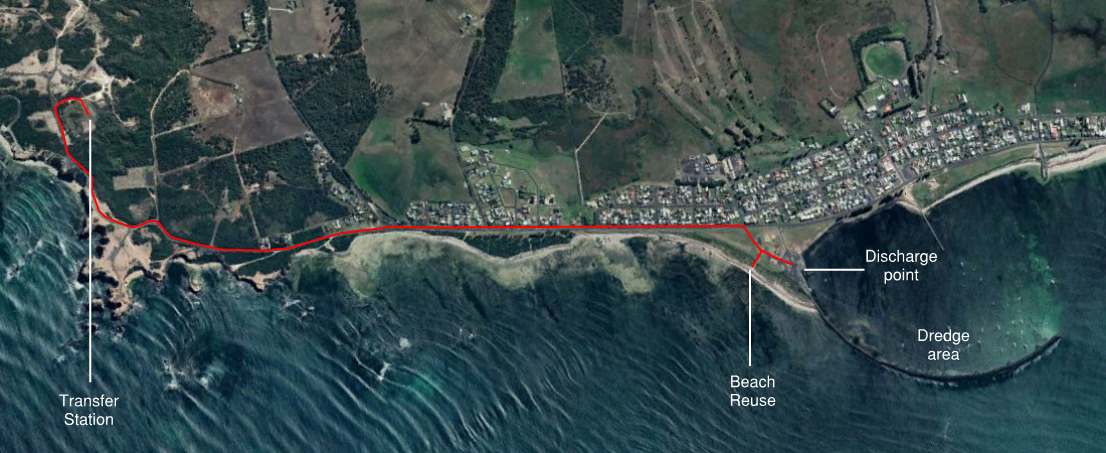Port MacDonnell Dredging Project
About the project
Major dredging works at Port MacDonnell commenced in late March 2022 and were completed in late August 2022 , ensuring ongoing safety and improved access to the harbour, boat ramp and mooring ground for boat users.
The Department for Infrastructure and Transport (DIT) undertook extensive consultation with the District Council of Grant from 2019 to 2022 to ensure the dredging of the area met the needs of the community and relevant stakeholders. The dredging works were subject to conditions of an Environment Protection Authority (EPA) licence.
Project works undertaken by a Department contractor included the removal of a significant accumulation of sandy materials at the harbour entrance as well as the mooring grounds.
Approximately 20,000 m3 of material was dredged as part of this project. Organic materials dredged from the channel were screened, drained and transported to the adjacent western beach.
Sand dredged from the harbour entrance was deposited for replenishment of sandy beaches located east of the harbour area.
The dredging helps improve productivity for local businesses and the fishing industry.
Port MacDonnell Dredging Project Update - 19 July 2022
Port MacDonnell Dredging Project Overview - 15 March 2022
Project Benefits
- Improved safety for Port MacDonnell harbour users.
- Improved access to the harbour by users
- Improved productivity for commercial fishers
Latest news
Visit this page for project updates.
March 2022 - ADVANCED WORKS NOTICE
FAQ’s
Why does dredging need to take place?
The site requires a major dredging campaign to remove significant accumulation of sandy materials at the harbour entrance and mooring grounds as well as seaweed (wrack) from the channel. This is to ensure the ongoing safe use of the Port MacDonnell harbour, boat ramp and mooring grounds.
Who is responsible for the dredging works?
The Department for Infrastructure and Transport (DIT) is responsible for the dredging project. DIT has contracted a specialist dredging company (Maritime Constructions) with vast experience in dredging to undertake the works. DIT has worked extensively with the Environment Protection Authority (EPA) to ensure it meets the stringent environmental standards outlined in the EPA’s Dredge Management Guidelines 2020.
Maritime Constructions are authorised to undertake these works subject to conditions of an Environment Protection Authority (EPA) licence.
DIT has undertaken extensive consultation with the District Council of Grant over the last two and half years to ensure the dredging works for the area meets the needs of the community while ensuring minimal impacts to the community, the fishing industry, environment and marine ecosystem.
When will the works begin and finish?
Works were undertaken between late March 2022 and August 2022, with works completed in late August 2022.
How do I navigate around the dredge and discharge pipelines:
Boats using the boat haven entrance are advised to use caution and follow the 4-knot speed limit that applies and maintain a safe speed within 100m of the dredge and discharge pipelines. The safe speed recommended is 4-knots.
Vessels will need to observe navigation signals from the dredge to make sure they are passing on the correct side. The correct side to pass is indicated by two diamonds during the day and two green lights at night. Only pass on this side. Never approach within 100m astern of the dredge.
Contacting the dredge on VHF 14 before arrival/departure will ensure safe navigation.
Signs containing the above information will be installed at multiple locations around the harbour for recreational and commercial vessel operators to refer to at any time.
Can I still use the boat ramp during the dredging works?
One of the boat ramp lanes will be closed during the dredging works during seaweed removal from the channel and inshore area. This will be clearly signposted at the boat ramp. The map below shows the western lane of the boat ramp that will still be accessible to the public during the works.

I have a mooring in the harbour. Will this be moved during the dredging works?
The DIT contractor will aim to work around the vessel moorings in the harbour where possible during the dredging operations. If a mooring needs to be moved to enable the dredge to continue work, the contractor will liaise with mooring owners. The contractor will use a hydrographic surveyor to locate the moorings and will ensure moorings are returned to the same spot once dredging has been completed.
I live very close to where the dredging takes place, will I be able to hear the dredging?
To ensure the dredging works are completed during the seasonal window, works will be undertaken at 24 hours a day, 7 days a week, providing it is meeting all EPA noise requirements and EPA regulations.
Works may be reduced to day only works when working in close proximity to the boat ramp. When dredging sand and replenishing beaches there will be additional sources of noise from a booster pump positioned on the shoreline and an excavator or dozer when building the beach.
Typically noise from the dredge and associated machinery is a low frequency consistent hum from diesel engines. Louder activities such as anchor handling or tracking machines will be avoided at night.
Hours of operations, and/or methods, may be modified if necessary based on feedback received directly the project team or to the EPA.
Pipe work at the start or end of the project will generate noise during the day due to the use of rattle guns, this is only to connect pipes together or separate them.
Where will the materials dredged be taken?
Approximately 20,000 m3 of material is proposed to be dredged as part of this project. The dredge locations are split into two main areas as shown on the aerial map below:
- Area 1 - Harbour channel contains predominantly seaweed wrack
- Area 2 - Harbour entrance and mooring grounds contains predominantly sand
Material is to be deposited of at two locations, seaweed wrack from the channel (Area 1) via a separation system at the boat ramp and transported by truck offsite and sand from the harbour entrance (Area 2) via replenishment of sandy beaches located to the east of the harbour area.


Why were the disposal methods chosen?
The on-shore disposal of all sand and seagrass wrack was selected as the preferred method to minimise impacts to the nearshore reefs and seagrass beds in the vicinity of the harbour. This is to help ensure the longer-term protection of the marine environment.
Will there be an odour from the dredged materials?
Organic materials dredged from the channel will be screened, drained, and progressively transported to the adjacent western beach or based on assessment of the beach capacity, offsite to the Council Transfer Station. The majority of materials will be fresh and not generate persistent odour although the EPA has approved a dredge management plan which identifies short-term odour may occur. Sediments dredged from Area 2 (shown below) will comprise sandy materials and not likely to generate any persistent odour.
If you have any concerns about the odour, you can log this with the DIT contractor Maritime Constructions via the Project Manager, Simon Spencer - 0499 777 297.

How will the beaches be affected?
Sand pumped by the dredge will be naturally dark grey in colour and will contain some seaweed. Once the sand has dried and become oxidised it will return to its natural whiter colour after a few days. Pumping sand requires even more water, so the beach will be shaped to channel the water, separating out the sand and letting the water return to the ocean without causing erosion or scouring. Beach works will progressively move along the beach as sand accumulates.
Do I need to be concerned about air quality and dust from the works?
Air quality and dust management is low risk for this dredging activity. All dredge spoil is discharged in the water and therefore is not a dust or air-quality risk.
Where will the waste and litter from the works be disposed of?
The project is split into three areas: site compound, dredge location and spoil discharge and pipeline locations. Each area always requires waste management with litter avoidance practices to be maintained by the contractor.
Are native flora and fauna at risk due to the dredging works?
As part of the development application and development of an approved Dredge Management Plan DIT consulted and sought advice from the Department for Environment and Water in relation to flora and fauna at risk due to the dredging works. Impacts to native flora or fauna will be avoided at all times. Direct interactions or significant impact or disturbance is highly unlikely given there is no proposed earthworks or traffic requirements required in or around the shoreline.
The contractor must ensure materials are stored in such a way as to not disturb or potentially disturb native fauna by unloading plant/materials in designated areas. Bunting will be erected if required, and dredging will cease if there are any safety concerns for either the flora or fauna. Works must be carried out on existing paths and along existing pipe routes.
What is in place to ensure marine mammals are not impacted during these works?
The contractor is required to visually monitor for the presence of marine mammals around the site at all times (i.e. within 300m of the dredge) and look for any unusual or stressed behaviour. Dredging will cease if any dolphins or seals are spotted within dangerous proximity to the dredging works (less than 5 metres).
All marine mammal sightings will be reported by the contractor and submitted to the Department for Environment and Water for monitoring.
Further information
Further information
To find out more about the project, or register to receive project updates, please
- call us on 1300 794 880
- email us at DIT.Engagement@sa.gov.au